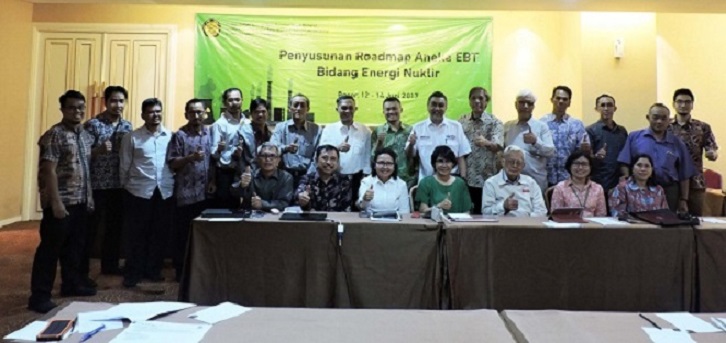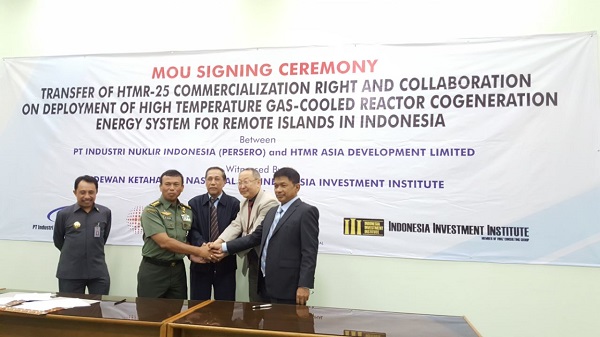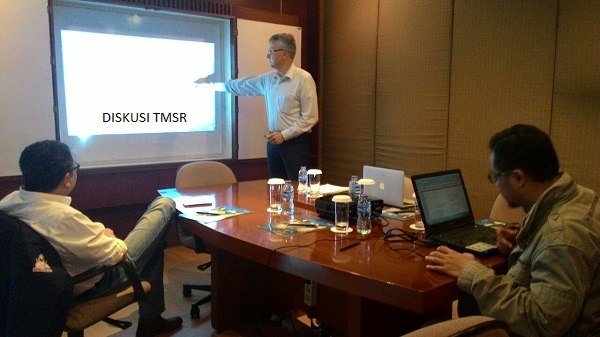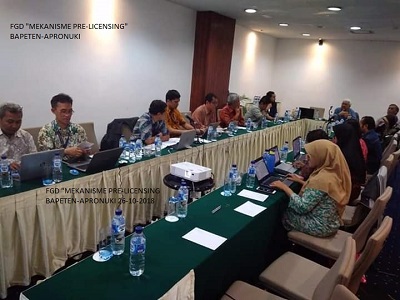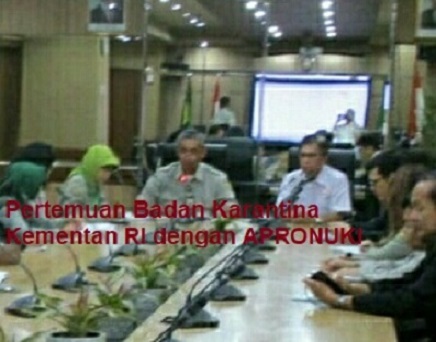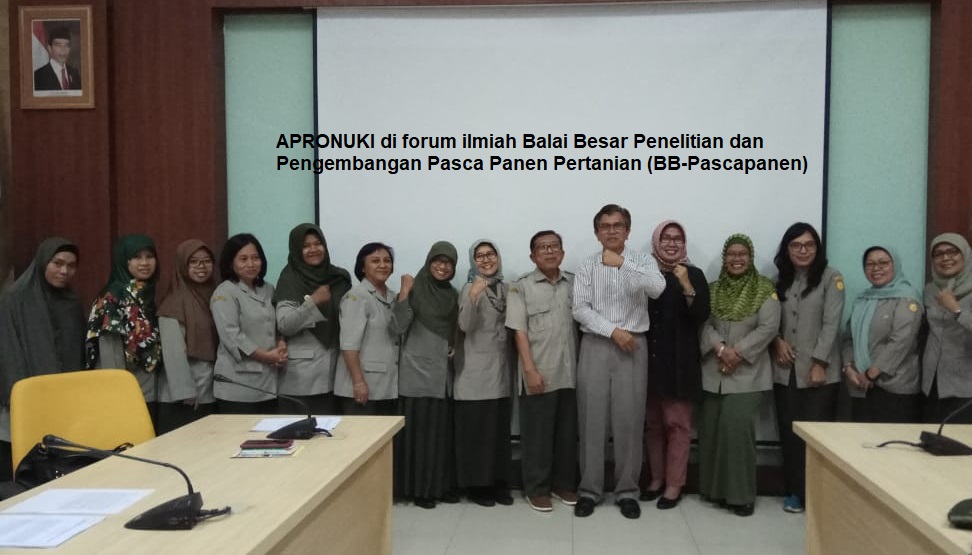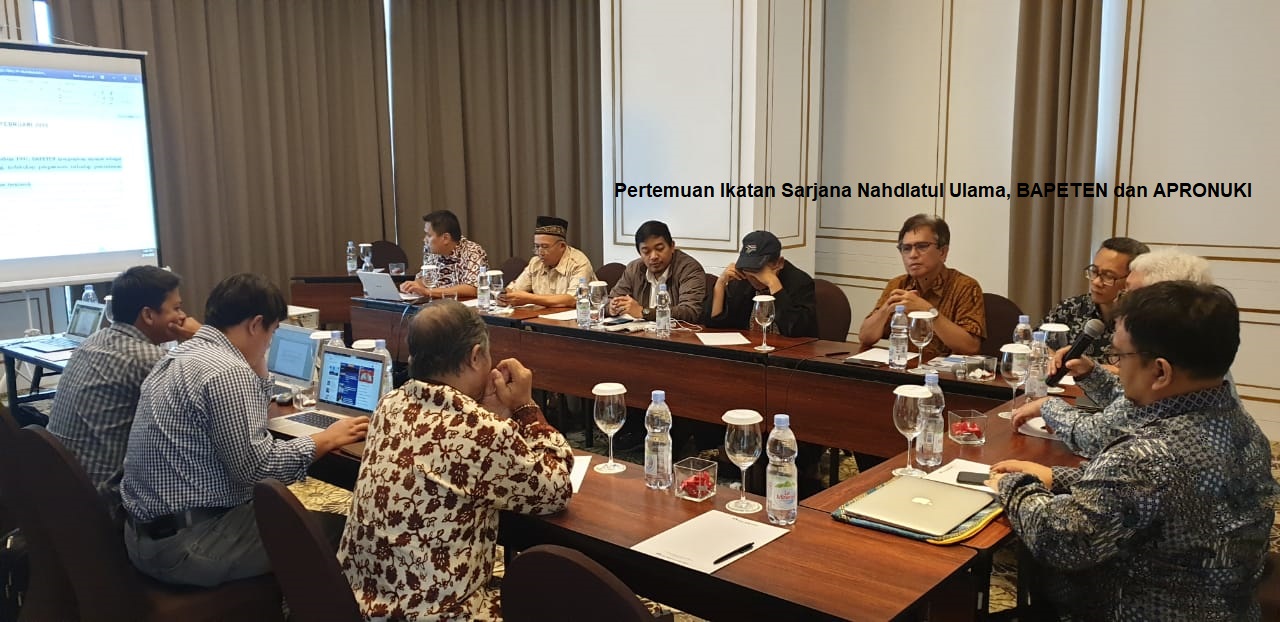 English
English
Hot Issues

APRONUKI has proposed 17 focus review areas for Molten Salt Reactor (MSR) and High Temperature Gas Cooled Reactor (HTGR) to BAPETEN (The Nuclear Energy Regulatory Agency of Indonesia):
1. Considering the passive safety features promised / owned by MSR and HTGR which are based on natural phenomena, not engineered safety features, it is deemed necessary to review regulations related to power (commercial) reactors.
2. Learn from the Canadian Nuclear Regulator CNSC which has adopted the IAEA Safety Standard Series SSR-2/1 (Rev 1) "Safety of Nuclear Power Plants: Design-specific Safety Requirements" to compile REGDOC-2.5.2. Based on the REGDOC, 19 focus areas of the review that were used by CNSC in the Gen-IV reactor pre-licensing process included IMSR (Integrated Molten Salt Reactor) from Terrestrial Energy.
3. For Gen-IV, in REGDOC-2.5.2 there is chapter 11 on "Alternative Approach".
4. APRONUKI adopted SSR-2/1 rev 1 to compile 17 focus review areas that have been proposed to BAPETEN.
5. Initial discussion on 17 focus review areas was conducted in a focus group discussion (FGD) with BAPETEN. In the focus area (focus area 7 on safety analysis) it is proposed to apply the risk-based review principle to determine the relevance of each focus area for reviewed nuclear power plants. In the FGD, BAPETEN stated that licensing of new types of reactors (such as MSR and HTGR) could be carried out with licensing mechanisms on the basis of experiments. For this reason, the reactor vendor can work with the Implementing Agency (BATAN) to build an experimental reactor.
6. The 17 focus review areas which are proposed by APRONUKI still need to be discussed in more detail with BAPETEN, especially for the preparation of guidelines that will be taken into consideration in improving regulations relating to existing new Nuclear Power Plants (especially BAPETEN regulations on Safety Provisions of Power Reactor Designs).
1. Considering the passive safety features promised / owned by MSR and HTGR which are based on natural phenomena, not engineered safety features, it is deemed necessary to review regulations related to power (commercial) reactors.
2. Learn from the Canadian Nuclear Regulator CNSC which has adopted the IAEA Safety Standard Series SSR-2/1 (Rev 1) "Safety of Nuclear Power Plants: Design-specific Safety Requirements" to compile REGDOC-2.5.2. Based on the REGDOC, 19 focus areas of the review that were used by CNSC in the Gen-IV reactor pre-licensing process included IMSR (Integrated Molten Salt Reactor) from Terrestrial Energy.
3. For Gen-IV, in REGDOC-2.5.2 there is chapter 11 on "Alternative Approach".
4. APRONUKI adopted SSR-2/1 rev 1 to compile 17 focus review areas that have been proposed to BAPETEN.
5. Initial discussion on 17 focus review areas was conducted in a focus group discussion (FGD) with BAPETEN. In the focus area (focus area 7 on safety analysis) it is proposed to apply the risk-based review principle to determine the relevance of each focus area for reviewed nuclear power plants. In the FGD, BAPETEN stated that licensing of new types of reactors (such as MSR and HTGR) could be carried out with licensing mechanisms on the basis of experiments. For this reason, the reactor vendor can work with the Implementing Agency (BATAN) to build an experimental reactor.
6. The 17 focus review areas which are proposed by APRONUKI still need to be discussed in more detail with BAPETEN, especially for the preparation of guidelines that will be taken into consideration in improving regulations relating to existing new Nuclear Power Plants (especially BAPETEN regulations on Safety Provisions of Power Reactor Designs).
STUDY ON THE NUCLEAR LEGAL AND REGULATORY FRAMEWORK IN ASEAN
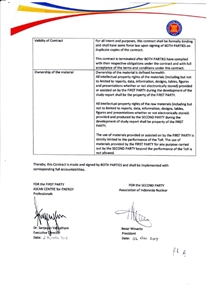
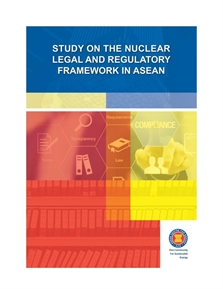
1
Health
Diagnose of cancer, heart, kidney and cancer therapy.
Gamma camera for diagnose of the function of blood flow and the location & size of cancer. The tool is not only used in the health sector, but also in the field of chemical process research to determine the hydrodynamic behavior of the fluidizedbed gas/solid and liquid/solid processes and in the visualization and monitoring of multi-phase flow phenomena in porous media.
The challenge of import substitution:
Detectors consisting of NaITl crystals and PMT matrix are still 100% imported. Similarly, processors to process the signal from detectors still use imported add-on card. Software for control and human machine interfaces is an opportunity to be developed domestically.
There are currently alternatives to NaI (Tl), namely LaBr3: Ce and CZT. Gamma cameras that use the LaBr3 detector: Ce and CZT have better spatial resolution and energy than gamma cameras based on NaI (Tl) scintillation arrays.
Positron Emission Tomography for cancer diagnose which is most accurate at present:
The challenge of import substitution:
The magnetic field generator in the form of an electromagnet is designed and constructed in BATAN. The RF cavity for electric field generation is still at the design stage; The ion source prototype has been realized by BATAN researchers. Further efforts need to be made to improve performance so that it is equivalent to the available ion sources in the market.
Production of x-ray/roentgen imaging system based on digital technology without film, a cheap but accurate kidney diagnostic tool (diagnosing blood flow to the kidneys, urine flow from the kidney to the bladder & physical diagnosis of kidneys).
The challenge of import substitution:
The x ray tube has been developed in BATAN but has been stopped since a long time ago, so until today it is still imported. Similarly, x ray detectors, especially x ray detector arrays still rely on imported products. Expectations of local content exist in software for signal processing, image processing, human-machine interface
Gamma camera for diagnose of the function of blood flow and the location & size of cancer. The tool is not only used in the health sector, but also in the field of chemical process research to determine the hydrodynamic behavior of the fluidizedbed gas/solid and liquid/solid processes and in the visualization and monitoring of multi-phase flow phenomena in porous media.
The challenge of import substitution:
Detectors consisting of NaITl crystals and PMT matrix are still 100% imported. Similarly, processors to process the signal from detectors still use imported add-on card. Software for control and human machine interfaces is an opportunity to be developed domestically.
There are currently alternatives to NaI (Tl), namely LaBr3: Ce and CZT. Gamma cameras that use the LaBr3 detector: Ce and CZT have better spatial resolution and energy than gamma cameras based on NaI (Tl) scintillation arrays.
Positron Emission Tomography for cancer diagnose which is most accurate at present:
The challenge of import substitution:
The magnetic field generator in the form of an electromagnet is designed and constructed in BATAN. The RF cavity for electric field generation is still at the design stage; The ion source prototype has been realized by BATAN researchers. Further efforts need to be made to improve performance so that it is equivalent to the available ion sources in the market.
Production of x-ray/roentgen imaging system based on digital technology without film, a cheap but accurate kidney diagnostic tool (diagnosing blood flow to the kidneys, urine flow from the kidney to the bladder & physical diagnosis of kidneys).
The challenge of import substitution:
The x ray tube has been developed in BATAN but has been stopped since a long time ago, so until today it is still imported. Similarly, x ray detectors, especially x ray detector arrays still rely on imported products. Expectations of local content exist in software for signal processing, image processing, human-machine interface
2
Energy
Melting free nuclear reactor: High Temperature Gas Cooled Reactor, Molten Salt Reactor
High Temperature Gas Cooled Reactor (HTGR), which is called as Catastrophe free nuclear reactor with a large local content potential due to the majority of the reactor core structure consists of graphite and concrete. HTGR produces heat (temperature around 900 degrees Celsius) and electricity. HTGR in Hamm Uentrop Germany is the first commercial plant in the world.
Molten Salt Reactor (MSR) which use Thorium as its main fuel. Operating pressure around atmospheric pressure, fuel and coolant freezes into solids at temperatures below 400 degrees Celsius are the main safety features of this type of reactor. Commercial plant is currently in the process of pre-licensing in Canada.
CHALLENGES: readiness of regulations for generation IV reactors, readiness of the Indonesian research community to cooperate with generation IV reactor developers to build prototypes for fullfilling requirements in licensing by test/experiments.
WHO HAS THE IDEAS & EARLY REALIZATION OF PEBBLE BED HIGH TEMPERATURE REACTOR?
Pebble bed HTR (High Temperature Reactor) was born from a concept developed by Prof. Schulten. He was the director of the Institute for Reactor Development at the Juelich Nuclear Research Center Germany. At present the name of the Center becomes Forschungszentrum Juelich. The concept was realized in the form of an experimental nuclear power plant that produced 25 MWe of electric power and was named AVR (Arbeitsgemeinschaft Versuchsreaktor) at the Juelich Nuclear Research Center.
AVR was designed, built and commissioned by BBC / HRB. The AVR commissioning was conducted on August 26, 1966 and the operation was stopped on December 1, 1988 with a total power of 1.7 TWh.
Furthermore, based on the experience gained from experiments at AVR, BBC / HRB built a Thorium high-temperature reactor at Hamm-Uentrop in Germany that can produce electrical power of 308 MWe. The nuclear power plant is named THTR 300 (Thorium High Temperature Reactor). Thorium was used to reduce the use of Uranium. Commissioning was carried out on September 13, 1983. The operation was stopped on September 29, 1988.
Because of political policy in Germany, the development of the HTR nuclear power plant was stopped.
Based on experience in the development of pebble beds HTR in Germany, HTR-10 was built with 10 MW thermal power in Tsin Hua University China. The experimental HTR is used for the development of pebble bed HTR technology in China, such as fuel testing and development, verification of the pebble bed HTR safety features, demonstration of electricity production and co-generation heat, and exploring experience in pebble bed HTR design, operation and construction.
Therefore, in collaboration to develop pebble bed HTR, research institutions in Indonesia need to consider not to take a country, which has not intensively developed the pebble bed HTR, as a main partner in the design. It should also be noted that companies that have experiences in designing, building and carrying out commissioning pebble bed HTR were BBC and HRB consortia, while for pebble bed HTR fuel manufacturing was NUKEM.
DISCUSSION ON MSR SAFETY REVIEW AND INDONESIAN NUCLEAR REGULATION: Regulatory readiness greatly influences readiness of supplying electricity or process heat (heat for process industries) from nuclear energy with a high level of safety in Indonesia.
Technological developments have achieved safety features based on natural phenomena, no longer relying on engineered safety features.
This development is in the form of several Generation IV nuclear power plant designs. The generation IV design which is currently prepared to deploy in Indonesia, is TMSR (Thorium Molten Salt Reactor) designed by Thorcon.
According to the attachment 1 of BAPETEN No. 3 of 2011 concerning SAFETY DESIGN OF POWER REACTOR PROVISIONS. PIE - Postulated Initiating Event are events that initiate a series of events and which result in:
1. AOO - Anticipated Operational Occurrences
2. DBA - Design Base Accident
3. Severe Accidents.
Similarly, according to the IAEA GS-G-4.1 "Format and Content of the Safety Analysis Report for Nuclear Power Plants".
It is stated in Article 3 that the Head Regulation of the BAPETEN applies to water-cooled power reactors built on land.
But based on the analysis and the results of the MSRE, accidents scenarios that have been identified are consistent with the category of events in the SAR (Safety Analysis Report) according to the IAEA GS-G-4.1.
Given the promised safety advantages in MSR, the application of regulation number BAPETEN No. 3 of 2011 needs to be carried out with a "graded approach" mechanism.
The implementation of a "graded approach" is proposed by applying "risk informed licensing". Thus the grading process is based on:
1. Safety analysis,
2. Regulatory requirements
3. Engineering judgment.
Regarding the safety analysis, APRONUKI proposes a Review Area Focus nr 7 which contains the following review steps:
1. Purpose of analysis
2. Analysis of hazard threats
3. Deterministic safety analysis
4. Safety assessment based on stages in risk informed design:
4.1. Accident scenario analysis
4.2. Failure Modes & Effect Analysis (FMEA).
4.3, Deterministic analysis to identify failure modes, FMEA is used as the basis for developing event trees by PRA analysts.
4.4. PRA (Probabilistic Risk Assessment) to identify dominant failure modes
4.5. Addition of safety features for mitigation or prevention of dominant failure modes
4.6. Steps 4.3 and 4.4 are repeated to meet the acceptance criteria for safety system design
Regarding the analysis of hazard threats or PIEs (according to Appendix 1, BAPETEN Nr. 3 of 2011 and the IAEA GS-G-4.1), PIEs in the MSR have been identified as follows:
1. AOT-abnormal operating transients:
The efficiency of the non soluble fission products extraction by helium bubbling, which is a key-point for the core neutron balance and safety concern.
The helium circulation in the reactor core will affect the reactivity (void effect).
2. DBA - Accident Base Design:
2.1. Power increase accident or RIA (reactivity initiated accident). PIE according to NRC and EPRI in RIA's "Technology Assessment of a Molten Salt Reactor Design (2015)" is: Unintentional control rod withdrawal.
2.2. Flow decrease accident (pump trip accident)
2.3. Fuel-salt leak accident (primary loop break accident)
Besides the 3 RIAs, APRONUKI also proposes:
a. Fuel salt channel blockage
b. Drain tank cooling mechanism design deficiency
It is necessary to review whether the following events are relevant to add as RIA:
a. Loss of coolant salt flow
b. Solar salt / Intermediate Coolant Salt Heat Exchanger failure
Another PIEs which can cause core damages according to NRC and EPRI in “Technology Assessment of a Molten Salt Reactor Design” (2015):
a. Breakage of one or more graphite tubes (e.g. due to Improper handling of graphite tubes during maintenance or inspection)
b. Improper or inadequate cooling of the drained fuel salt
c. Partially thawed piece of salt plug or solid mass obstructs piping to the drain tank. e.g. Freeze valve design deficiency
3. Severe accidents
The source term:
Tritium production and the different ways to reduce it and to trap the tritium in the primary and secondary circuits.
The MSRE remains the principal source of knowledge of fission product behavior in molten fluoride salts. There, it was observed that:
(1) noble gasses (e.g., xenon, krypton) will bubble out freely in to an off-gassing system,
(2) many fission products (including caesium) form stable fluorides and are permanently retained in the salt, and
(3) certain noble metals and tellurium will not form fluorides nor remain in solution, but rather plate out on the surfaces of the primary circuit.
MSR has a Small Accident Source Term due to:
• Reduced radionuclide source term
• Low pressure
• Off-gas system selectively removes volatile components
• Salt chemistry limits release of radionuclides under reactor accident conditions
− Low iodine release potential
− Low cesium release potential
MSR has potential for processing accidents:
Off-Gas System
• Significant radionuclide inventory
− Xenon (with high decay heat)
− Krypton
− Other
The krypton and xenon fission product gases have a very low solubility in the fuel salt and will naturally bubble out.
High Temperature Gas Cooled Reactor (HTGR), which is called as Catastrophe free nuclear reactor with a large local content potential due to the majority of the reactor core structure consists of graphite and concrete. HTGR produces heat (temperature around 900 degrees Celsius) and electricity. HTGR in Hamm Uentrop Germany is the first commercial plant in the world.
Molten Salt Reactor (MSR) which use Thorium as its main fuel. Operating pressure around atmospheric pressure, fuel and coolant freezes into solids at temperatures below 400 degrees Celsius are the main safety features of this type of reactor. Commercial plant is currently in the process of pre-licensing in Canada.
CHALLENGES: readiness of regulations for generation IV reactors, readiness of the Indonesian research community to cooperate with generation IV reactor developers to build prototypes for fullfilling requirements in licensing by test/experiments.
WHO HAS THE IDEAS & EARLY REALIZATION OF PEBBLE BED HIGH TEMPERATURE REACTOR?
Pebble bed HTR (High Temperature Reactor) was born from a concept developed by Prof. Schulten. He was the director of the Institute for Reactor Development at the Juelich Nuclear Research Center Germany. At present the name of the Center becomes Forschungszentrum Juelich. The concept was realized in the form of an experimental nuclear power plant that produced 25 MWe of electric power and was named AVR (Arbeitsgemeinschaft Versuchsreaktor) at the Juelich Nuclear Research Center.
AVR was designed, built and commissioned by BBC / HRB. The AVR commissioning was conducted on August 26, 1966 and the operation was stopped on December 1, 1988 with a total power of 1.7 TWh.
Furthermore, based on the experience gained from experiments at AVR, BBC / HRB built a Thorium high-temperature reactor at Hamm-Uentrop in Germany that can produce electrical power of 308 MWe. The nuclear power plant is named THTR 300 (Thorium High Temperature Reactor). Thorium was used to reduce the use of Uranium. Commissioning was carried out on September 13, 1983. The operation was stopped on September 29, 1988.
Because of political policy in Germany, the development of the HTR nuclear power plant was stopped.
Based on experience in the development of pebble beds HTR in Germany, HTR-10 was built with 10 MW thermal power in Tsin Hua University China. The experimental HTR is used for the development of pebble bed HTR technology in China, such as fuel testing and development, verification of the pebble bed HTR safety features, demonstration of electricity production and co-generation heat, and exploring experience in pebble bed HTR design, operation and construction.
Therefore, in collaboration to develop pebble bed HTR, research institutions in Indonesia need to consider not to take a country, which has not intensively developed the pebble bed HTR, as a main partner in the design. It should also be noted that companies that have experiences in designing, building and carrying out commissioning pebble bed HTR were BBC and HRB consortia, while for pebble bed HTR fuel manufacturing was NUKEM.
DISCUSSION ON MSR SAFETY REVIEW AND INDONESIAN NUCLEAR REGULATION: Regulatory readiness greatly influences readiness of supplying electricity or process heat (heat for process industries) from nuclear energy with a high level of safety in Indonesia.
Technological developments have achieved safety features based on natural phenomena, no longer relying on engineered safety features.
This development is in the form of several Generation IV nuclear power plant designs. The generation IV design which is currently prepared to deploy in Indonesia, is TMSR (Thorium Molten Salt Reactor) designed by Thorcon.
According to the attachment 1 of BAPETEN No. 3 of 2011 concerning SAFETY DESIGN OF POWER REACTOR PROVISIONS. PIE - Postulated Initiating Event are events that initiate a series of events and which result in:
1. AOO - Anticipated Operational Occurrences
2. DBA - Design Base Accident
3. Severe Accidents.
Similarly, according to the IAEA GS-G-4.1 "Format and Content of the Safety Analysis Report for Nuclear Power Plants".
It is stated in Article 3 that the Head Regulation of the BAPETEN applies to water-cooled power reactors built on land.
But based on the analysis and the results of the MSRE, accidents scenarios that have been identified are consistent with the category of events in the SAR (Safety Analysis Report) according to the IAEA GS-G-4.1.
Given the promised safety advantages in MSR, the application of regulation number BAPETEN No. 3 of 2011 needs to be carried out with a "graded approach" mechanism.
The implementation of a "graded approach" is proposed by applying "risk informed licensing". Thus the grading process is based on:
1. Safety analysis,
2. Regulatory requirements
3. Engineering judgment.
Regarding the safety analysis, APRONUKI proposes a Review Area Focus nr 7 which contains the following review steps:
1. Purpose of analysis
2. Analysis of hazard threats
3. Deterministic safety analysis
4. Safety assessment based on stages in risk informed design:
4.1. Accident scenario analysis
4.2. Failure Modes & Effect Analysis (FMEA).
4.3, Deterministic analysis to identify failure modes, FMEA is used as the basis for developing event trees by PRA analysts.
4.4. PRA (Probabilistic Risk Assessment) to identify dominant failure modes
4.5. Addition of safety features for mitigation or prevention of dominant failure modes
4.6. Steps 4.3 and 4.4 are repeated to meet the acceptance criteria for safety system design
Regarding the analysis of hazard threats or PIEs (according to Appendix 1, BAPETEN Nr. 3 of 2011 and the IAEA GS-G-4.1), PIEs in the MSR have been identified as follows:
1. AOT-abnormal operating transients:
The efficiency of the non soluble fission products extraction by helium bubbling, which is a key-point for the core neutron balance and safety concern.
The helium circulation in the reactor core will affect the reactivity (void effect).
2. DBA - Accident Base Design:
2.1. Power increase accident or RIA (reactivity initiated accident). PIE according to NRC and EPRI in RIA's "Technology Assessment of a Molten Salt Reactor Design (2015)" is: Unintentional control rod withdrawal.
2.2. Flow decrease accident (pump trip accident)
2.3. Fuel-salt leak accident (primary loop break accident)
Besides the 3 RIAs, APRONUKI also proposes:
a. Fuel salt channel blockage
b. Drain tank cooling mechanism design deficiency
It is necessary to review whether the following events are relevant to add as RIA:
a. Loss of coolant salt flow
b. Solar salt / Intermediate Coolant Salt Heat Exchanger failure
Another PIEs which can cause core damages according to NRC and EPRI in “Technology Assessment of a Molten Salt Reactor Design” (2015):
a. Breakage of one or more graphite tubes (e.g. due to Improper handling of graphite tubes during maintenance or inspection)
b. Improper or inadequate cooling of the drained fuel salt
c. Partially thawed piece of salt plug or solid mass obstructs piping to the drain tank. e.g. Freeze valve design deficiency
3. Severe accidents
The source term:
Tritium production and the different ways to reduce it and to trap the tritium in the primary and secondary circuits.
The MSRE remains the principal source of knowledge of fission product behavior in molten fluoride salts. There, it was observed that:
(1) noble gasses (e.g., xenon, krypton) will bubble out freely in to an off-gassing system,
(2) many fission products (including caesium) form stable fluorides and are permanently retained in the salt, and
(3) certain noble metals and tellurium will not form fluorides nor remain in solution, but rather plate out on the surfaces of the primary circuit.
MSR has a Small Accident Source Term due to:
• Reduced radionuclide source term
• Low pressure
• Off-gas system selectively removes volatile components
• Salt chemistry limits release of radionuclides under reactor accident conditions
− Low iodine release potential
− Low cesium release potential
MSR has potential for processing accidents:
Off-Gas System
• Significant radionuclide inventory
− Xenon (with high decay heat)
− Krypton
− Other
The krypton and xenon fission product gases have a very low solubility in the fuel salt and will naturally bubble out.
3
Industry
Nucleonic control system, NDT, production of isotopes for health, Electron Beam or gamma radiation for cross linking, degradation and sterilization processes,electron beam for flue gas treatment (Reduksi NO2 dan SOx), thorium, zirconium & rare earth elements extraction and purification and its aplications:
CHALLENGES: application of robotic in isotope production to reduce radiation exposure on workers, large area electron beam, environtment friendly extraction process.
EXAMPLE OF NUCLEAR EQUIPMENTS: Non Destructive Test uses Gamma-based digital technology so that it no longer requires films and uses robotics technology to apply the ALARA principle.
On line elemental analyzer using gamma neutron prompt activation analyzer for the cement and coal industries
Baby cycloctron for isotope production which is used in PET - Positron Emission Tomography (the most accurate cancer diagnosis tool at present)
Emission control methods using electron beam (EBFGT-Electron Beam Flue Gas Treatment) excel economical compared to Wet flue gas desulphurization (FGD), Selective catalytic reduction (SCR) and combined Wet FGD + SCR. Even EBFGT byproducts which are collected in the electrostatic precipitator can be used for fertilizers that have been registered in fertilizer regulation in Japan.
The environment friendly extraction process of thorium, zirconium, titanium and rare earth elements
CHALLENGES: application of robotic in isotope production to reduce radiation exposure on workers, large area electron beam, environtment friendly extraction process.
EXAMPLE OF NUCLEAR EQUIPMENTS: Non Destructive Test uses Gamma-based digital technology so that it no longer requires films and uses robotics technology to apply the ALARA principle.
On line elemental analyzer using gamma neutron prompt activation analyzer for the cement and coal industries
Baby cycloctron for isotope production which is used in PET - Positron Emission Tomography (the most accurate cancer diagnosis tool at present)
Emission control methods using electron beam (EBFGT-Electron Beam Flue Gas Treatment) excel economical compared to Wet flue gas desulphurization (FGD), Selective catalytic reduction (SCR) and combined Wet FGD + SCR. Even EBFGT byproducts which are collected in the electrostatic precipitator can be used for fertilizers that have been registered in fertilizer regulation in Japan.
The environment friendly extraction process of thorium, zirconium, titanium and rare earth elements
4
Technology Transfer
HOW CHINESE GOVERNMENT USE A GREAT DOMESTIC MARKET for the needs of technology transfer and to achieve the goal of developing national technological capabilities (example of fast railroad technology):
The policy of the Chinese government to strengthen the global competitiveness of domestic fast railroad companies is explicitly stated in official state documents detailing the use of technology transfer agreements as a key to realizing the goal of technology development.
The "China High Speed Train United Action Plan Cooperation Agreement" was signed between the Ministry of Science (MoS) and the Ministry of Railways (MoR) on February 26, 2008 which contains cooperation between the two parties:
1. Development of technology to realize a network capable of supporting railroad speeds of 350 km/h or more.
2. Realizing independent intellectual property rights and increasing global competitiveness.
3. Exporting technology.
MoS provided funds of nearly 10 billion RMB ($ 1.6 billion), involving 25 universities, 11 research institutions, 51 national laboratories and engineering research centers (Science and Technology Daily, September 6, 2010). The MoR also mobilizes universities, science and technology research centers and manufacturing companies to carry out the "introduction, digestion, absorption and re-innovation program locomotive" (People’s Daily, September 5, 2008).
In 2003, when it was decided to build the Beijing-Shanghai line, it was discovered that Chinese companies were unable to meet the HSR development targets. According to MoR spokesman Zhang Shuguang, China needs more than a decade to be equal to developed countries because of the costs and difficulties of developing domestic technology.
As a solution, China uses a large domestic market for technology transfer needs and achieves the goal of developing national capabilities through: digestion, absorption and re-innovation (yinjin xiaohua xishou zai chuangxin) foreign technology.
On June 17, 2004, MoR announced the first auction for the procurement of railroad technology 200 km/hour. The government stipulates that the economic benefits of foreign participation must prioritize profits for the Chinese economy not for foreign economies (Xinhua, March 4, 2010) with the main goal of technology transfer that supports China in technology development.
The criteria established by MoR include competing pricing and that companies that win an auction must comprehensively transfer technology to Chinese companies and finished products must use the Chinese trademark. Foreign partners must provide technical services and training so that Chinese companies must be able to function without foreign partnerships (National Technology and Equipment Network, March 18, 2010). Chinese companies are free to determine foreign partners, but foreign partners must attend pre-bid and sign technology transfer agreements with domestic companies (Xinhua September 4, 2004). The government also stipulates that foreign companies must transfer not only existing technology to China, but also further development (Xinhua, March 4, 2010).
Alstom (France), Siemens (Germany), Bombardier (Canada) and a consortium of Japanese companies led by Kawasaki Heavy Industries participated in the auction from China. All must adopt the China standard for their high-speed rail products and assemble all units by joint ventures
The policy of the Chinese government to strengthen the global competitiveness of domestic fast railroad companies is explicitly stated in official state documents detailing the use of technology transfer agreements as a key to realizing the goal of technology development.
The "China High Speed Train United Action Plan Cooperation Agreement" was signed between the Ministry of Science (MoS) and the Ministry of Railways (MoR) on February 26, 2008 which contains cooperation between the two parties:
1. Development of technology to realize a network capable of supporting railroad speeds of 350 km/h or more.
2. Realizing independent intellectual property rights and increasing global competitiveness.
3. Exporting technology.
MoS provided funds of nearly 10 billion RMB ($ 1.6 billion), involving 25 universities, 11 research institutions, 51 national laboratories and engineering research centers (Science and Technology Daily, September 6, 2010). The MoR also mobilizes universities, science and technology research centers and manufacturing companies to carry out the "introduction, digestion, absorption and re-innovation program locomotive" (People’s Daily, September 5, 2008).
In 2003, when it was decided to build the Beijing-Shanghai line, it was discovered that Chinese companies were unable to meet the HSR development targets. According to MoR spokesman Zhang Shuguang, China needs more than a decade to be equal to developed countries because of the costs and difficulties of developing domestic technology.
As a solution, China uses a large domestic market for technology transfer needs and achieves the goal of developing national capabilities through: digestion, absorption and re-innovation (yinjin xiaohua xishou zai chuangxin) foreign technology.
On June 17, 2004, MoR announced the first auction for the procurement of railroad technology 200 km/hour. The government stipulates that the economic benefits of foreign participation must prioritize profits for the Chinese economy not for foreign economies (Xinhua, March 4, 2010) with the main goal of technology transfer that supports China in technology development.
The criteria established by MoR include competing pricing and that companies that win an auction must comprehensively transfer technology to Chinese companies and finished products must use the Chinese trademark. Foreign partners must provide technical services and training so that Chinese companies must be able to function without foreign partnerships (National Technology and Equipment Network, March 18, 2010). Chinese companies are free to determine foreign partners, but foreign partners must attend pre-bid and sign technology transfer agreements with domestic companies (Xinhua September 4, 2004). The government also stipulates that foreign companies must transfer not only existing technology to China, but also further development (Xinhua, March 4, 2010).
Alstom (France), Siemens (Germany), Bombardier (Canada) and a consortium of Japanese companies led by Kawasaki Heavy Industries participated in the auction from China. All must adopt the China standard for their high-speed rail products and assemble all units by joint ventures
Economy Information
Pengunjung:
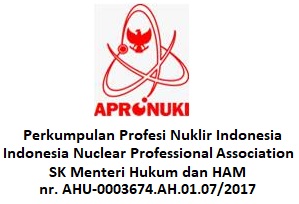
 Indonesia
Indonesia
